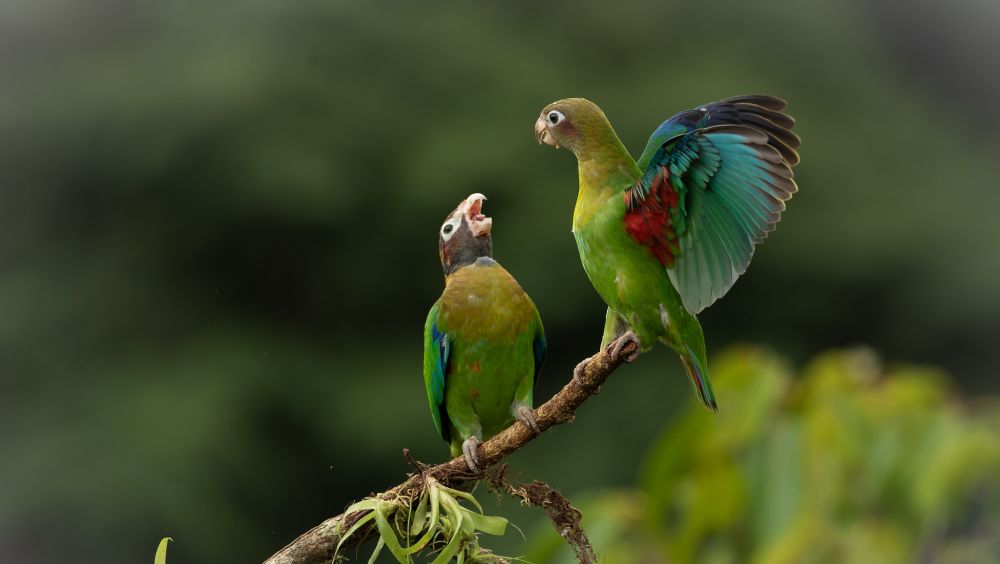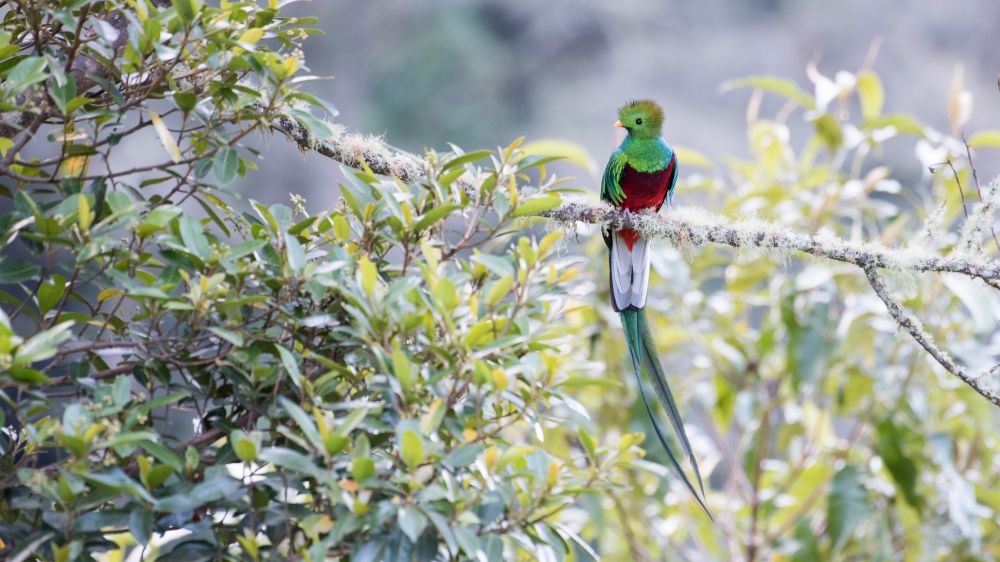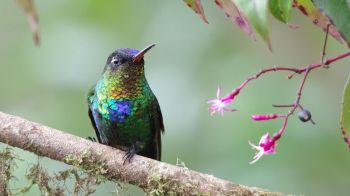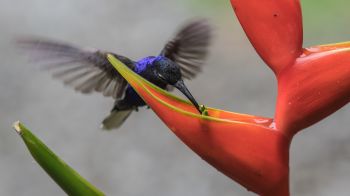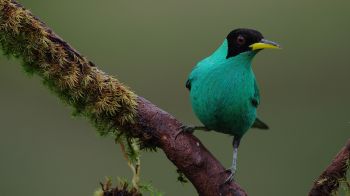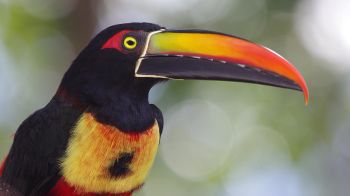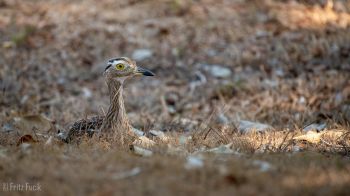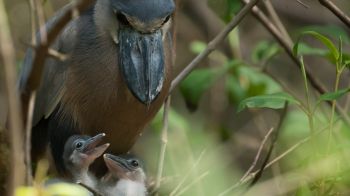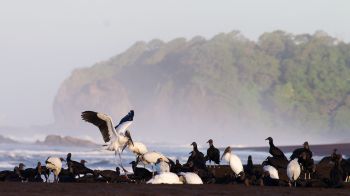- Exotic bird life in diverse habitats
- Highest volcano of Costa Rica
- Research field stations in the jungle
- Archaeological site
- Trekking through Cloud and Rain forests
- Tropical flora and fauna
Roundtrip Colibri - Birdwatching
Toucans, hummingbirds, macaws, herons, quetzals, birds of prey and owls are just a few representatives of Costa Rica's very diverse exotic bird life, which you will experience during the Amadeus round trip "Colibri" off the beaten track. Its location on the narrow land bridge between North and South America as well as a very recent geological and natural history make Costa Rica a melting pot of lush fauna and flora with an extraordinary biodiversity between the Atlantic and Pacific coast. Many endemics, local and migrant species feel at home in these numerous habitats and ecosystems.
On just 51,100 square kilometers (19.700 square miles) of land, more than 930 bird species from 82 families have been sighted so far (more than in Canada and the USA combined). In addition to nature observations with a focus on ornithology, this round trip will also take you closer to cultural and historical aspects of our little stunning paradise, hosting nearly 6% of the world's biodiversity; not forgotten its hospitable inhabitants, the Ticos and Ticas as they call themselves.
Day 1: Upon arrival in San José, your English-speaking Amadeus tour guide welcomes you at the airport terminal exit. After a short transfer to the hotel, make yourself comfortable in your room and get to know the other members of the tour group short time after.
Accommodation: Villa San Ignacio. Meal plan: none
Day 2: Passing extensive market gardens, we drive up to the Irazú National Park. The volcano of the same name is the highest in the country at 3,432 m (11,259 ft.). We hike leisurely through the crater landscape to reach the summit. Up there we enjoy the breathtaking views of the three craters as part of the volcano. Afterwards we visit the former state capital Cartago (until 1823) located at the foot of the volcano. Of course, we won’t miss the gorgeous basilica with its sanctuary, the Virgen de Los Ángeles - a black Madonna who is said to have healing powers. Affectionately called "La Negrita" by the population, she is also the patron saint of Costa Rica. By the end of the day, a scenery drive across the dam of Lake Cachí takes us to the Hotel Quelitales, located in the eastern highlands. Their wide and lush gardens as well as the surrounding nature are home to over 400 species of birds. Emblematic are the Highland Tinamou (Nothocercus bonapartei), Scaled Antpitta (Grallaria guatimalensis), Ochre-breasted Antpitta (Grallaricula flavirostris), Black-bellied Hummingbird (Eupherusa nigriventris), Green-fronted Lancebill (Doryfera ludovicae), Coppery-headed Emerald (Microchera cupreiceps), Cabanis's Ground-Sparrow (Melozone cabanisi), Barred Parakeet (Bolborhynchus lineola).
Accommodation: Hotel Quelitales. Meal plan: Breakfast
Day 3: Early in the morning we are on the prowlfor bird watching in the area around the hotel. A little later we approachthe nearby Tapantí National Park, well known for its pleasant and regenerating climate. The 583 km² (225 sqm) protected area of low montane rainforest and premontane forest extends 1,220 (4,000 ft.) to 2,560 m (8398 ft.) above sea level. The area is one of the rainiest in Costa Rica and is crossed by the Río Grande de Orosi River, into which most of the park's watercourses flow.More than 260 species of birds have been spotted in Tapantí National Park, including quetzals, falcons, hawks, grouse, pigeons, orioles, hummingbirds, parakeets, tinamous and tanagers. The enjoyment of this extremely species-rich rainforest with untouched fauna and flora is an unforgettable nature experience.
Accommodation: Hotel Quelitales. Meal plan: Breakfast
Day 4: The vicinity of the village of Sarapiqui to the La Selva research station of the OTS (Organization for Tropical Studies) is going to be our next exciting destination. The 1,600-ha protected area consists mainly of original and reforested lowland rainforest, which adjoins the Braulio Carrillo National Park. The 4 to 6 km wide corridor that connects La Selva at 35 m above sea level with the Barva volcano at 2,906 m (9,534 ft.) above sea level is among the best-preserved ones in the tropics. OTS is a consortium of about 50 universities and research institutes worldwide, which opened the La Selva Research Station in 1968. In addition to the education and research purposes, OTS was a pioneer of private tropical forest protection in the country. This became a nationwide network of hundreds of independent, privately owned nature reserves. La Salva’s flora and fauna is simply impressive, with 470 species of birds spotted so far. In the late afternoon we reach our lodge, which is located on the river shores of Rio Sarapiquí.
Accommodation: Selva Verde Lodge. Meal plan: Breakfast, Dinner
Day 5: Today we visit the nearby Tirimbina Rainforest for bird watching, another private conservation project with a research and education purpose. It comprises 345 hectares of primary forest (85%), secondary forest and former cultivated areas, such as cocoa. 9 km of forest paths and two suspension bridges lead through the extensive grounds, which are under the protection of the Costa Rican NGO ATCIE (Association for Conservation, Research and Education). Over 300 species of birds have been spotted only in Tirimbina, including Golden-winged Warbler (Vermivora chrysoptera), Sunbittern (Eurypyga helias), White-fronted Nunbird (Monasa morphoeus), Snowy Cotinga (Carpodectes nitidus), Royal Flycatcher (Onychorhynchus coronatus), Slaty-breasted Tinamou (Crypturellus boucardi), White-necked Puffbird (Notharchus hyperrhynchus). In the afternoon you will be taken through the agricultural zone around Pital, with its extensive pineapple plantations. Towards the end of the day, the hotel staff of Maquenque Eco Lodge, located in the very north of the country, give us a warm welcome. Enjoy your dinner accompanied by amazing tropical sounds.
Accommodation: Maquenque Lodge. Meal plan: Breakfast, Dinner
Day 6: In the morning a refreshing hike through the lodge's 220-hectare forest reserve will boost as one of the most biodiverse ones in Costa Rica; it surely feels special to observe this diverse bird life. Giant trees with exotic flowers and tall palm trees with wide-spreading leaves are the habitat of numerous green macaws. These endangered parrots croak loudly from the treetops. A unique experience for your senses. If you prefer, you may explore a nearby lagoon with its tropical fauna and flora by canoe on your own. The surrounding area also offers numerous opportunities for optional leisure activities. In the evening your guide invites you to participate in a guided night hike. We explore the lively nocturnal hustle and bustle of the flora and fauna in the gardens and forests around the lodge. Numerous animal species such as caimans, snakes, spiders, frogs and many more form a fascinating soundscape at night with their natural sounds.
Accommodation: Maquenque Lodge. Meal plan: Breakfast, Dinner
Day 7: After breakfast we leave the lodge and drive through varied landscapes of the Caribbean Plains. On the way take advantage of several scheduled stops at some distinctive viewpoints. Our journey takes us to La Fortuna de San Carlos, close to the active Arenal Volcano. Luckily, the colossus is also responsible for the pleasant warm thermal springs of this area. In La Fortuna take a hike at the foot of the volcano, where you will experience the splendor of the almost perfectly conical, 1,633 m (5,357 ft.) high Arenal Volcano. Enjoy excellent views, including petrified lava flows, while spotting animals such as howler monkeys, sloths, wild boars, and exotic birds such as toucans and hawks. At the end of the day, optionally relax and feel at ease in the pleasantly warm waters of the Ecotermales hot springs.
Accommodation: Arenal Observatory Lodge. Meal plan: Breakfast
Day 8: In the morning, our adventurous, tropical journey continues by driving across a dam along the picturesque Lake Arenal, the largest inland lake in the country and home to many species of waterfowl. While driving along this stunning scenery, some photo stops at striking viewpoints cannot be missed out. On the way to Monteverde we visit the finca of the Bello family, where coffee is still grown organically based on family tradition. Here we see ourselves transported back to a time when the Ticos, as the inhabitants of Costa Rica call themselves, came to prosperity. The Bello family is a member of the local coffee cooperative, which sells part of its coffee harvest to Europe through Fair Trade. After visiting the plantation, we taste a cup of freshly brewed coffee and enjoy a light snack in a cozy atmosphere together with the family. Gradually, the landscape changes and we drive up the hills. Our cozy mountain hotel in the cloud forest area of Monteverde ("green mountains") awaits us in the afternoon.
Accommodation: Hotel Trapp Family. Meal plan: Breakfast
Day 9: Today the world-renowned Monteverde Cloud Forest Reserve is our first stop. It was established in 1972 by scientists from the Tropical Science Center (TSC) and local Quaker families with the aim to protect the remaining pristine cloud forest areas. Located on the Tilarán mountain range, it covers 4,125 hectares and is home to an estimated 50% of Costa Rica's rich biodiversity, including 425 species of birds and 3,200 species of plants. The year-round cloud forest climate creates and preserves a lush green mountain landscape. The Reserva Biológica Bosque Nuboso Monteverde extends from 1,400 m (4,593 ft.) above sea level on the Pacific side up to the continental divide and descends to the valley of the Peñas Blancas River towards the Atlantic side. Exploring this precious reserve passing across the extensive network of trails in the dense cloud forest, not to forget several lookout platforms, a magnificent panoramic view over the surrounding wooded hills offers whatever your eyes may catch. Thrill seekers can then book an optional canopy tour or so-called zip line hundreds of meters from tree to tree through the canopy passing by waterfalls always towards the valley. Or why not hiking on across several suspension bridges, between and above stunning tree tops, discovering the cloud forest from a totally different perspective (optional).
Accommodation: Hotel Trapp Family. Meal plan: Breakfast
Day 10: After breakfast and with lots of memorable moments in our minds, we leave the high-altitude Monteverde cloud forest always downhill with the Pacific coast nearby. On the way we stop at Hacienda Nosavar on the river banks of Río Tárcoles near the Carara National Park. There you will explore the unique fauna and flora of this Central Pacific region during a boat tour on the Río Tárcoles. It offers a perfect opportunity to discover a mangrove area with its eminent biodiversity, which is considered as the habitat of one of the most important populations of the huge American crocodile. The four mangrove tree species found here are also home to many species of waterfowl (that’s about 250 species, including herons, roseate spoonbills, storks as well as the colorful scarlet macaws) as well as tropical reptiles and mammals. Most probably, American crocodiles up to 5 meters (16 ft.) tall, storks and other animals can also be observed. After a delicious lunch, the journey continues south along the Pacific coast to the Hotel Cristal Ballena. It is located on a slope near the beach town of Uvita and the Bahía Ballena Marine National Park.
Accommodation: Hotel Cristal Ballena. Meal plan: Breakfast, Lunch
Day 11: A visit to Costa Rica without having seen the UNESCO World Heritage Site Diquís with its archaeological sites, may also be considered somehow incomplete. The elevated position of Batambal, with a view of the river Térraba, the ocean and the delta plain, may have contributed to the foundation of the original settlement around 300 AD. About 500 years later, the site was repopulated, with buildings with river stone bases and stone spheres, sculptures and petroglyphs. Due to its strategic location, the settlement probably had a ceremonial character. In the municipal park of the village of Palmar Sur we can then marvel at impressive specimens of the well-known stone spheres - pre-Columbian artefacts, which the Diquís people carved and polished almost spherically from granite-like boulders with basic stone tools. The same park features also the historic Locomotiva 84 steam engine, which started transporting bananas and goods in the region in 1935. In the afternoon we will arrive at the Esquinas Rainforest Lodge.
Accommodation: Esquinas Rainforest Lodge. Meal plan: Breakfast, Dinner
Day 12: We visit the neighboring research station La Gamba, a scientific research, study and further education institution of the University of Vienna, directly adjacent to the Peñas Blancas National Park. Located in the small community of the same name, it makes significant contributions to the study of tropical rainforests in one of the most diverse lowland rainforests in Mesoamerica. Due to geographical and geological conditions, this forest area located at the entrance to a valley with about 3,000 vascular plant species also has a species-rich fauna. The 142 km² (54 sqm) large and dense jungle is also home to more special and endemic bird species (including curassows, parakeets, hummingbirds, flycatchers, toucans) in its diverse habitats. The La Gamba Reserve was bought out of exploitation and destruction in 1993 by an exemplary campaign of the Viennese musician Prof. Michael Schnitzler with donations from the citizens of Austria and has since been known under the symbolic name Rainforest of the Austrians.
Accommodation: Esquinas Lodge. Meal plan: Breakfast, Dinner
Day 13: In the morning, we observe the diverse bird life in the extensive grounds of the lodge. Later the journey continues inland via San Isidro del General, the most populous city in the southwest of the country, to the mountain valley of San Gerardo de Dota in the Central Cordillera. The Cerro de la Muerte is a mountain peak of a massif in the Tapantí - Cerro de la Muerte National Park and the highest point (3335 m / 10941 ft.) of the Panamericana. Higher areas are mainly home to paramo habitats with gnarled shrubs, dwarf bamboo, tree ferns and small plants. Below, the natural vegetation consists of primary oak forests with bamboo undergrowth, excellent for the observation of birds, particularly the quetzal. The rugged peak of Cerro Chirripó is the highest point (3820 m / 12532 ft.) in the country.
Accommodation: Hotel Savegre. Meal plan: Breakfast, Dinner
Day 14: Early in the morning we look for the green and scarlet colored quetzal (Pharomachrus mocinho) in its natural environment. San Gerardo de Dota is known as the best place in the country to see this mystical and iconic Bird of the Gods of the Aztec and Mayan cultures. Evergreen oak forest with bromeliads, ferns, orchids and mosses covers every corner of the area. Following the song of the Quetzal in its magical flight and depending on its migration pattern, we experience the lush green surroundings and can enjoy the tranquility of the highland cloud forest. Later, we will discover its extraordinary flora and fauna, including other representatives of the bird world, on an extended hike through the evergreen terrain and pristine forests of the valley. Some typical bird species are Yellow-thighed Brushfinch (Atlapetes tibialis), Dark Pewee (Contopus lugubris), Northern Emerald-Toucanet (Aulacorhynchus prasinus), Green-crowned Brilliant (Heliodoxa jacula), White-throated Mountain-gem (Lampornis castaneoventris), Volcano Hummingbird (Selasphorus flammula), Scintillant Hummingbird (Selasphorus scintilla), Collared Trogon (Trogon collaris), Acorn Woodpecker (Melanerpes formicivorus).
Accommodation: Hotel Savegre. Meal plan: Breakfast, Dinner
Day 15: After breakfast, it is time to say goodbye to the mountainous region of San Gerardo and return to San José. The Central Market there is no doubt a special place to explore (closed on Sundays). This vegetable and fruit market that spreads out in a large hall will enchant you with its colorful variety of colors and smells. Our last impression for today will be the incomparable and famous Gold Museum by the main square, whose objects d'art bear witness to the mastery of the country's prehistoric goldsmiths. Your voyage ends with a bus transfer to the international airport.
Meal plan: Breakfast
| Name | Days | Stars ICT | Parking | Swimmingpool | Spa | Restaurant | AC | TV | WIFI | |
|---|---|---|---|---|---|---|---|---|---|---|
| Villa San Ignacio Hotel | 1 | |||||||||
| Selva Verde Lodge | 4 | |||||||||
| Maquenque Eco Lodge | 5,6 | |||||||||
| Arenal Observatory Lodge & Spa | 7 | |||||||||
| Trapp Family Hotel | 8,9 | |||||||||
| Cristal Ballena Hotel | 10 | |||||||||
| Esquinas Rainforest Lodge | 11,12 | |||||||||
| Savegre Hotel Natural Reserve & Spa | 13,14 |
| 15 Days / 14 Nights | Single | Double | |
|---|---|---|---|
| 2 Persons | 7055 | 6140 | |
| 3 Persons | 5950 | 5035 | |
| 4 Persons | 5850 | 4935 | |
| 5 - 7 Persons | 5500 | 4585 | |
| 8 - 12 Persons | 4990 | 4075 | |
| single room supplement | 915 | ||
| All Prices in USD | |||
Services included
Guided Tour
- All Transfers.
- All overnight stays are based on double occupancy with breakfast incl.
- 1 lunch, 7 dinner
- All entrance fees listed in the table Activities and National Parks.
- Qualified English-speaking tour guide, specialized in birdwatching
- Transport in modern, comfortable and fully air-conditioned vehicles.
- EU safety guidelines for drivers and driving times are maintained.
- 24-hour English-speaking emergency hotline (25+ years of experience in Costa Rica)

We would like to thank all our guests who have been travelling with us since 1994 in the most beautiful time of the year - their well-deserved holidays. When developing itineraries for groups and individual travelers, selecting our local service partners and caring about the well-being of our guests, we always focus on the highest possible quality standards. Since the founding of Amadeus Travel, we have been committed to sustainable tourism as the only long-term viable form of tourism, e.g. through our social commitment, visiting and supporting private and state nature reserves as well as the training of our team and experienced, fully licenced tour guides.











 Book Now
Book Now 
